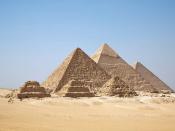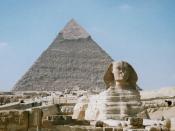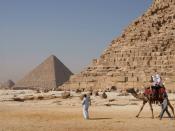The Great Pyramid of Gizeh is on top of the list of Wonders of The World. The monument was built for the Egyptian pharaoh Khufu around the year 2600 BC to serve as his tomb and is believed to have been built over a 20 year period. The construction of the Great Pyramid has had far-reaching consequences, from sparking the interest of amateur astronomers to influencing Newton's law of gravitation. The Great Pyramid and its mathematical conundrums has both excited and flummoxed mathematicians for almost as long as the science of math has existed.
Historically, the mathematics surrounding the design of the pyramid remained a mystery for many centuries. Bonnie M. Sampsell, in The Egyptian Study Society's The Ostracon suggests that the Egyptians may have used much simpler mathematics than some might think. She describes how the Egyptians use of the seked (a horizontal displacement of one cubit), and likens it to the modern day use of the 'rise and run method', which carpenters use for building staircases.
J.P. Lepre, in his book The Egyptian Pyramids: A Comprehensive, Illustrated reference, describes how the pyramids may have been built around a center pole using four circles, hiding the underlying mathematical principles from the 10,000 or so workers that built the pyramid. O. Neubebauer further demystifies the building of the pyramids by explaining in his work On The Orientation of Pyramids, that the Egyptians may simply have used a small pyramidal model and aligned that model according to the position of the shadow over the course of a day.
Much of the mathematics evident in the Great Pyramid's structure appears to deal with basic time measurements. The base angle of 52 degrees, might lead even a casual reader to note that there might be a link with the calendar. However,


